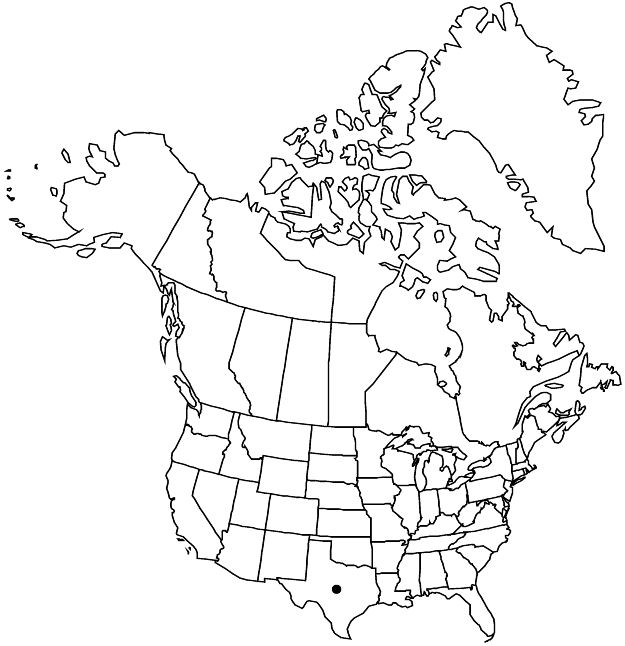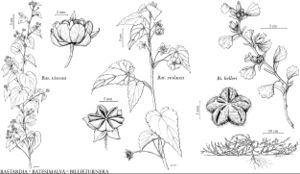Difference between revisions of "Batesimalva violacea"
Bol. Soc. Bot. México 35: 26. 1975.
FNA>Volume Importer |
imported>Volume Importer |
||
| (6 intermediate revisions by 2 users not shown) | |||
| Line 12: | Line 12: | ||
}}{{Treatment/ID/Special_status | }}{{Treatment/ID/Special_status | ||
|code=F | |code=F | ||
| − | |label= | + | |label=Illustrated |
}} | }} | ||
| − | |basionyms={{Treatment/ID/ | + | |basionyms={{Treatment/ID/Basionym |
|name=Gaya violacea | |name=Gaya violacea | ||
|authority=Rose | |authority=Rose | ||
| + | |rank=species | ||
| + | |publication_title=Contr. U.S. Natl. Herb. | ||
| + | |publication_place=12: 286. 1909 | ||
}} | }} | ||
|synonyms= | |synonyms= | ||
| Line 34: | Line 37: | ||
|distribution=Tex.;Mexico (Coahuila;Nuevo León). | |distribution=Tex.;Mexico (Coahuila;Nuevo León). | ||
|discussion=<p>Of conservation concern.</p><!-- | |discussion=<p>Of conservation concern.</p><!-- | ||
| − | --><p>In the flora area, Batesimalva violacea is known from only a single station in Big Bend National Park.</p> | + | --><p>In the flora area, <i>Batesimalva violacea</i> is known from only a single station in Big Bend National Park.</p> |
|tables= | |tables= | ||
|references= | |references= | ||
| Line 43: | Line 46: | ||
-->{{#Taxon: | -->{{#Taxon: | ||
name=Batesimalva violacea | name=Batesimalva violacea | ||
| − | |||
|authority=(Rose) Fryxell | |authority=(Rose) Fryxell | ||
|rank=species | |rank=species | ||
| Line 57: | Line 59: | ||
|publication title=Bol. Soc. Bot. México | |publication title=Bol. Soc. Bot. México | ||
|publication year=1975 | |publication year=1975 | ||
| − | |special status=Conservation concern; | + | |special status=Conservation concern;Illustrated |
| − | |source xml=https:// | + | |source xml=https://bitbucket.org/aafc-mbb/fna-data-curation/src/2e0870ddd59836b60bcf96646a41e87ea5a5943a/coarse_grained_fna_xml/V6/V6_427.xml |
|subfamily=Malvaceae subfam. Malvoideae | |subfamily=Malvaceae subfam. Malvoideae | ||
|genus=Batesimalva | |genus=Batesimalva | ||
Latest revision as of 23:21, 5 November 2020
Plants 1.5–2 m. Stems stellate-tomentose and with simple hairs 1–1.5 mm. Leaves: stipules to 0.5 mm; petiole 3/4 to as long as blade; blade discolorous, 6–10 cm, apex acute or acuminate, surfaces densely, velvety pubescent abaxially, sparsely hairy adaxially. Pedicels slender, elongate, 2–6.5 cm. Flowers: calyx 6–8 mm, tomentulose and with long, simple hairs; petals 6–8 mm; staminal column 2–3 mm, glabrous; anthers yellow. Schizocarps 10–12 mm diam.; mericarps with proximal cell partially covered by endoglossum 1 mm. Seeds 2.5 mm. 2n = 32.
Phenology: Flowering fall.
Habitat: Dry, deciduous forests and shrublands
Elevation: 600–800 m
Distribution

Tex., Mexico (Coahuila, Nuevo León).
Discussion
Of conservation concern.
In the flora area, Batesimalva violacea is known from only a single station in Big Bend National Park.
Selected References
None.
